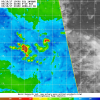Webberweather53
Meteorologist
A strong tropical wave located ~ 35W has continued to show signs of organization over the last day or so, thus the National Hurricane Center (NHC) has increased the probability of tropical cyclogenesis to 40% over the next 5 days as this wave reaches the southern Lesser Antilles, Aruba, and the northern portions of Venezuela and thus the NHC has designated it as 92L. While it's relatively low latitude, climatology (and eventually the central America monsoon gyre) is (will be) working against the development of this system, the environment ahead appears marginally conducive for gradual development of 92L, with a relatively moist environment, augmented by a tropical wave axis centered a little ahead of 92L ~45W, and low wind shear (~ 5-15 knots). However, regardless of whether TCG occurs in the next several days, 92L will more than likely become sheared apart by upper level outflow from the CA monsoon gyre over the eastern Caribbean, and canonical lower level trade wind divergence in the east-central Caribbean (wherein easterly trade winds accelerate as they're squeezed between Hispaniola, Puerto Rico, and South America and tend to preclude TCG, especially in the first half of the hurricane season). Post away!































